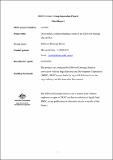| Other Contributor | Brooks, I |
| Date Accessioned | 2013-10-15 |
| Date Available | 2013-10-15 |
| Issued | 2008 |
| Identifier | http://hdl.handle.net/11079/12657 |
| Abstract | The Silkwood Drainage Board Area (SDBA) encompasses a catchment area of approximately 1200 hectares using a system of drains which are both man made and redesigned natural streams. There are roughly 16 kilometres of drainage system. In the North Queensland Wet Tropics it is essential to have an efficient and effective drainage system to allow sugar cane or any other crop to be free of water logging and excessive flooding. The SDBA is an ideal demonstration area because most of the farm runoff is contained within the drainage scheme. This allows for the collecting of data to evaluate the effectiveness of different drainage models. By incorporating a system of sediment trapping into the farm layout, off farm sediment losses can be reduced. Soil erosion by water has been identified as a research priority especially for the farms within the Great Barrier Reef Catchment Area. Environmental factors such as slope, rainfall intensity, soil structure and soil cover are interacting factors producing sediment runoff. Farmers can manage soil structure and soil cover in ratoon cane through green cane thrash blanket and minimum tillage systems but currently the plant cane farming systems still entails the intense cultivation of ground. There are combinations of factors restricting change on the ground to a total minimum tillage planting system. Factors such as; the high cost to change equipment, the necessity to carry out earth works on particular paddocks such as levelling and drainage works and the changing over of row widths and wheel centre spacings to the new dual row system. These all require complete cultivation of the paddock. Other environmental factors such as slope and rainfall also have an effect on sediment runoff. Therefore farm management needs to consider how it can offset the effects from these factors. Sediment trapping systems should be considered as an effective solution in a farm management program to mitigate the effects of paddock cultivation, high rainfall and slope erosion. |
| Language | en |
| Part of Series | Internal Report; 2008 GGP027 |
| Subject | Silkwood Drainage Board Area (SDBA) |
| Subject | North Queensland Wet Tropics |
| Subject | Drainage scheme |
| Subject | Grower group |
| Subject | Sediment trapping |
| Subject | Farm layout |
| Subject | Drainage models |
| Subject | Sediment losses |
| Subject | Farm management |
| Subject | Erosion |
| Subject | Great Barrier Reef
Catchment Area (GBRCA) |
| Subject | Environment |
| Subject | Nutrient loss |
| Subject | Measure sediment runoff |
| Subject | Sediment trap design |
| Subject | Water quality |
| Subject | Turbidity |
| Subject | Sediment Trap Field Guide |
| Title | SRDC Grower Group innovation project final report Developing a sediment trapping system in the Silkwood drainage board area (SDBA) |

